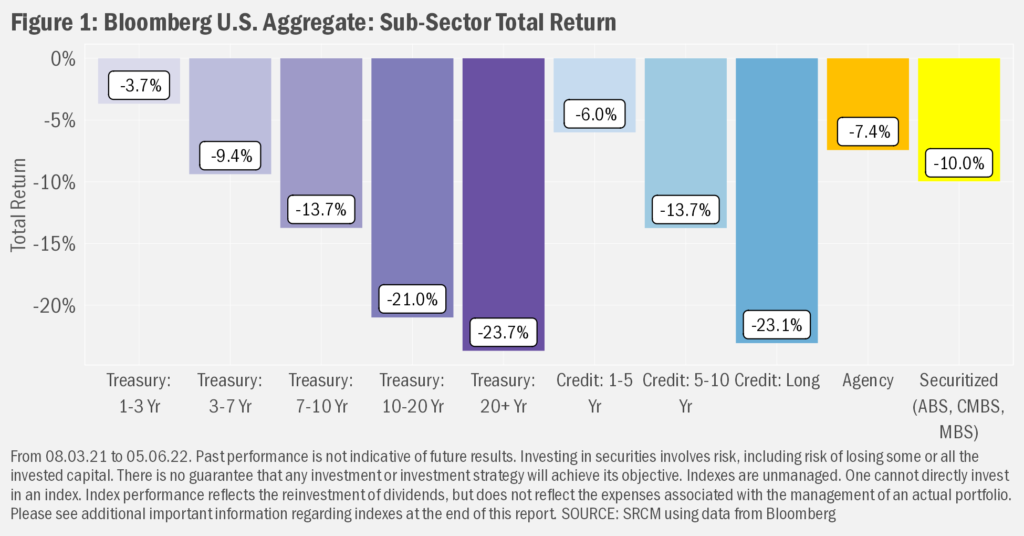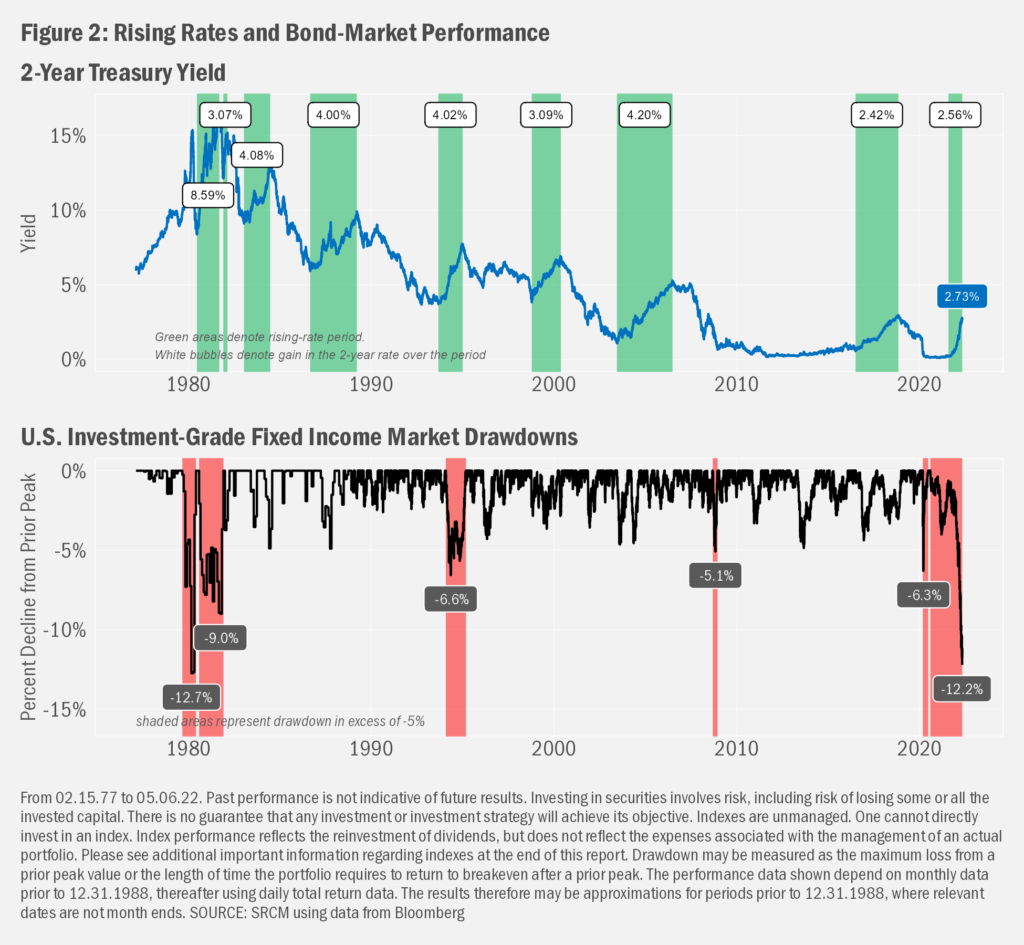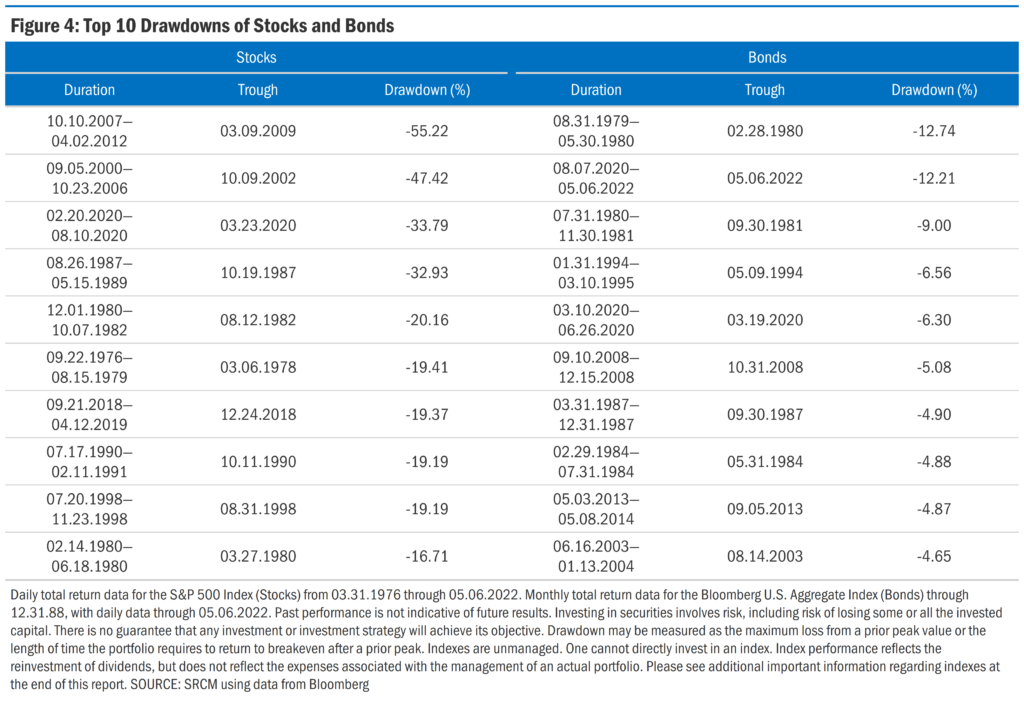Only once before in the history of the U.S. fixed income market have investment-grade bonds suffered as steep a decline as their current drawdown. The consequence of the impending reversal of stupendously accommodative, COVID-focused monetary policy, rates have risen from historical depths to put them likely within striking distance of what might be appropriate for “normal” macroeconomic conditions. The upshot is:
- Bond markets have raced ahead of actual shifts in monetary policy, pulling forward the effective implementation of expected policy moves
- And that may mean the bulk of the damage to fixed income portfolios might be complete
- Risks remain, however, that inflation could surprise on the upside and/or growth on the downside, heightening the challenges and hazards of an already intensely complicated project for the Fed
Listen to this month's Notes from the CIO podcast:
Podcast: Play in new window
Duration Illustrated
A basic rule of fixed income investing is that bond prices move in the opposite direction of interest rates. A second rule states that the longer the time until a bond matures—shorthand for the bond’s “duration”—the more sensitive that bond will be to changes in interest rates. Given the first rule, as interest rates began a sustained rise last year, bond prices began to fall. Taken as a whole, the U.S. investment-grade bond market has dropped just over 11.7% from
August 3 last year, when the interest rate on 2-year Treasury bonds reached another low point of 0.17%, having bounced around for more than a year after reaching a post-COVID crisis depth of 0.10% on February 5, 2021.
Some bonds fared better and some worse than that, though. Demonstrative of the second rule we stated earlier, the longer the duration of the bond, the deeper the price decline. As we show in Figure 2, longer-maturity bond markets suffered the greatest losses. Those with 20 years or more until maturity have sunk on average more than 21%. Short-term bonds, on the other hand, have fallen by much smaller amounts. Corporate bonds suffered a similar fate, with their prices falling even a bit more than those for Treasuries of comparable maturity on account of widening “spreads”, or the extra interest investors demand to reflect the fact that corporations can default on their bonds, potentially leaving investors with less than full return of the bond’s face value.

Rising Apace
Yet another rule of fixed income investing is that the impact of interest rate changes with respect to bond maturity are complicated by the level of rates at which one is doing the math. The lower the initial starting point for the change in rates, the greater the likely impact of the change in rates will have on the price of the bond. The fact that the shift upward in rates began at such a low level is part of the reason that the current drawdown was bested only by the shift in rates prompted by Federal Reserve actions taken in the late 1970s and early 1980s to combat then rampant inflation. Exacerbating the decline is the pace at which rates have risen: there’s been little time for the extra income provided by higher rates to offset the decline in bond prices.

Close to Normal?
As we recorded the last time we experienced a rather rapid increase in interest rates (there are a few on-topic commentaries from early 2018), the U.S. Federal Reserve is tasked with fostering a stable environment for macroeconomic growth as qualified by full employment and price stability (low and stable inflation). They seek to achieve this goal primarily by targeting levels of interest rates in the broader economy. Lower rates can be seen as “accommodating” growth, while higher rates can be seen as “restricting” growth.
Seeking to direct changes in the interest rates in the U.S., the Federal Reserve maintains a target for the federal funds rate, which is the rate that banks charge one another for overnight lending. The reasons banks do this are varied, but the rate is best thought of as the most immediate of lending rates in the U.S. Most other rates—those on U.S. Treasuries, corporate bonds, mortgages, bank loans and credit card APRs and others—key off this rate in some fashion. The belief, then, is that changes to the fed funds rate can steer changes to lending rates across the economy.
Theory suggests that lower rates make debt less expensive (lower interest payments on loans and newly issued bonds), which fosters investment that may, in turn, result in faster macroeconomic growth. Seen in reverse, higher rates are thought to slow macroeconomic activity. The Fed thus seeks to lower rates when it wants to enhance conditions for growth in macroeconomic activity and seeks to increase rates when it wishes to tamp down the potential for growth.
Interest rates might be considered “neutral” when the net effect on macroeconomic activity balances, with the economy at full employment and experiencing stably positive, but low inflation. Looking at the history of Treasury yields (Figure 3), though, one might think that we still have a long way to go before we reach “normal”. One could think, too, that Figure 3 suggests there might not be such a thing as normal. In fact, both statements could be true. While there are many ways to arrive at a subjectively quantitative assessment of the neutral rate of interest in advance of achieving it, we likely only will know when that rate is achieved when we can observe the Fed’s goals as having been met.
During his conference call on May 4 this week, shortly after the Fed announced a 50 basis-point hike in its target for the federal funds rate, Fed Chairman Jerome Powell confirmed as much, noting: “When we talk about the neutral rate, we are really talking about the rate that that neither pushes economic activity higher, nor slows it down. It’s a concept, really. It’s not something we can identify with any precision. So, we estimate it within broad bands of uncertainty. And the current estimates on the [Federal Reserve Open Market] Committee are sort of 2% to 3%. That’s a longer-run estimate...that’s an estimate for an economy at full employment and 2% inflation. Really what we are doing is we’re raising rates expeditiously to what we see as the broad range of plausible levels of neutral. But we know that there’s not a bright line drawn on the road that tells us when we get there. Our policies affect financial conditions and financial conditions affect the economy. So, we are going to look at the effect of our policy moves on financial conditions. Are they tightening appropriately? And then we are going to be looking at the effects on the economy. And we’re gonna be making a judgement about whether we’ve done enough to get us on a path to restore price stability.”
That is, the Federal Reserve might target a particular level of interest rates that it believes will support its full employment and price stability mandates, but only the achievement of the latter two will tell us that the neutral level has been met. Further challenging the math, as it were, the universe evolves such that the neutral rate of interest is thought to change through time as well. And sometimes the Fed’s targeting of one goal may come at the expense of the other. The current situation is among those times when such offsetting impacts might prove more challenging to manage. With inflation so high at the present, the Federal Reserve likely is more squarely focused on it, potentially at the expense of the employment rate. And that forced balancing act leaves wide open the possibility that the Fed’s actions either work too slowly to reduce the damage inflicted by high rates of inflation, or too quickly such that macroeconomic activity slows beyond desired levels, with a recession the potential undesirable outcome of that scenario.
Avoiding those strongly negative outcomes is top-of-mind for Team Fed, though, another point that Chairman Powell reiterated during his presser. And he’s confident—as he, of course, must be, at least in public—that the path remains open to what would be seen as a “soft landing” or a progression of the broader interest rate environment that modulates macroeconomic activity just enough to reach desired levels of inflation, 2%, while not seeing too much pressure on employment or growth. We remain in the believers’ camp—of the likelihood of success, that is, not just the possibility of success—even as we know the challenge remains a great one.

Not Riskless; Not Riskiest
And even then, we imagine the universe will conspire to alter the trajectory of interest rates yet again. Perhaps the war in Ukraine worsens. Or the world is hit with another round of COVID-related stress. Inflation could remain too hot, pressuring the Fed to raise rates even further than presently expected. Those and other potentially dire scenarios in mind, despite the historically substantial drawdown seen in global bond markets, we continue to find bonds to be the far more stable partners to risker equity in portfolios; the list of historical drawdowns for U.S. stocks and U.S. investment-grade bonds shown in Figure 4 supports this view.
What’s to Come?
Of course, we would have liked for rates to have moved up in a more leisurely manner, limiting the near-term drawdown in bond exposures, especially considering the fact that global equity markets have seen a drawdown only marginally greater than the U.S. investment-grade bond market. As we noted in January this year, our repositioning of portfolios acknowledged the likely higher path for interest rates this year. While the repositioning helped to avoid a good portion of the broader market’s losses, we missed not all of it, and worse still may yet come.
As we noted earlier, though, with rates having increased so quickly, the bond market has pulled forward much of the work the Federal Reserve so far has planned to accomplish in order to tame inflation. We therefore expect rates to remain a bit more range-bound until such time as current trends—a slow decline in inflation and mostly stable employment—markedly change course. In the meantime, the obvious benefit of higher interest rates is that the going-forward expected return on bonds has grown sharply in 2022.
Important Information
Statera Asset Management is a dba of Signature Resources Capital Management, LLC (SRCM), which is a Registered Investment Advisor. Registration of an investment adviser does not imply any specific level of skill or training. The information contained herein has been prepared solely for informational purposes and is not an offer to buy or sell any security or to participate in any trading strategy. Any decision to utilize the services described herein should be made after reviewing such definitive investment management agreement and SRCM’s Form ADV Part 2A and 2Bs and conducting such due diligence as the client deems necessary and consulting the client’s own legal, accounting and tax advisors in order to make an independent determination of the suitability and consequences of SRCM services. Any portfolio with SRCM involves significant risk, including a complete loss of capital. The applicable definitive investment management agreement and Form ADV Part 2 contains a more thorough discussion of risk and conflict, which should be carefully reviewed prior to making any investment decision. Please contact your investment adviser representative to obtain a copy of Form ADV Part 2. All data presented herein is unaudited, subject to revision by SRCM, and is provided solely as a guide to current expectations.
The opinions expressed herein are those of SRCM as of the date of writing and are subject to change. The material is based on SRCM proprietary research and analysis of global markets and investing. The information and/or analysis contained in this material have been compiled, or arrived at, from sources believed to be reliable; however, SRCM does not make any representation as to their accuracy or completeness and does not accept liability for any loss arising from the use hereof. Some internally generated information may be considered theoretical in nature and is subject to inherent limitations associated thereby. Any market exposures referenced may or may not be represented in portfolios of clients of SRCM or its affiliates, and do not represent all securities purchased, sold or recommended for client accounts. The reader should not assume that any investments in market exposures identified or described were or will be profitable. The information in this material may contain projections or other forward-looking statements regarding future events, targets or expectations, and are current as of the date indicated. There is no assurance that such events or targets will be achieved. Thus, potential outcomes may be significantly different. This material is not intended as and should not be used to provide investment advice and is not an offer to sell a security or a solicitation or an offer, or a recommendation, to buy a security. Investors should consult with an advisor to determine the appropriate investment vehicle.
The S&P 500 Index measures the performance of the large-cap segment of the U.S. equity market.
The Bloomberg U.S. Aggregate Bond Index is a broad-based flagship benchmark that measures the investment grade, U.S. dollar-denominated, fixed-rate taxable bond market. The index includes Treasuries, government-related and corporate securities, MBS (agency fixed-rate pass-throughs), ABS and CMBS (agency and non-agency).
One cannot invest directly in an index. Index performance does not reflect the expenses associated with the management of an actual portfolio.
Investing in any investment vehicle carries risk, including the possible loss of principal, and there can be no assurance that any investment strategy will provide positive performance over a period of time. The asset classes and/or investment strategies described in this publication may not be suitable for all investors. Investment decisions should be made based on the investor's specific financial needs and objectives, goals, time horizon, tax liability and risk tolerance.

